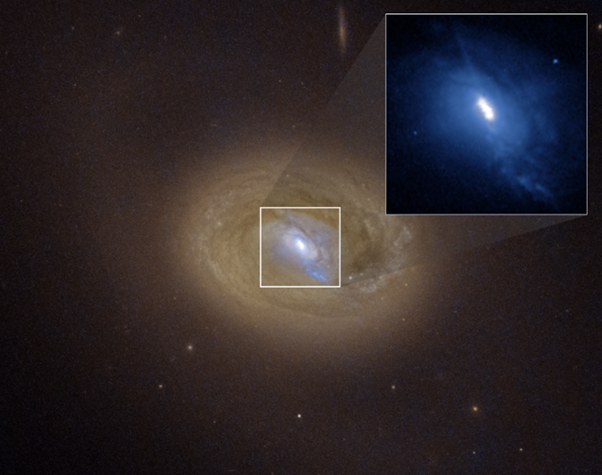A pair of supermassive black holes have been observed on the road to merging as their galaxies come together. The pair, seen by both the Hubble Space Telescope and Chandra X-ray Observatory are 300-400 light-years apart, which for most purposes is a great distance, but makes for the least separation ever confirmed between behemoths like these. This provides an unprecedented opportunity to study what happens when enormous black holes approach each other.
Unlike individual stars, galaxies run into each other very frequently, if by frequent you mean once every few billion years. With most large and medium-sized galaxies having supermassive black holes (SMBHs) at their cores, galactic collisions bring them into contact. Just this week a paper made the case that our own galaxy’s SMBH shows signs of having swallowed another 9 billion years ago.
SMBH’s can drive the chemistry of their whole galaxy, and the interactions between them are likely to stir things up in ways astronomers are keen to understand. The process of coming together takes tens of millions of years at least, but if we can see examples at different stages it’s almost like getting a stop motion film.
The galaxy MCG-03-34-64 is unusual for the amount of gas it holds, offering plenty of potential for future star formation, and is known for its very short wavelength X-ray spectrum. When Hubble and Chandra studied the intense brightness at its core they found something else. The brightness, known as an Active Galactic Nucleus (AGN), is a product of material falling into a black hole and heating up through friction as it does.

Hubble’s image of MCG-03-34-064 with the center expanded. Three bright spots are visible on close observation, two of which have the X-ray emissions indicative or black holes. The third is probably a patch of gas.
Image credit: NASA, ESA, Anna Trindade Falcão (CfA); image processing: Joseph DePasquale (STScI)
In this case, however, the telescopes revealed there are two SMBHs contributing to that light. We can’t see either directly of course, or even the shadow like we did with M87, but Hubble picked up diffraction spikes from hot oxygen gas, indicating great brightness in a tiny part of its field of view. The suspicion that this indicated a second accretion disk within the main one was confirmed using X-rays collected by Chandra.
“When we looked at MCG-03-34-64 in the X-ray band, we saw two separated, powerful sources of high-energy emission coincident with the bright optical points of light seen with Hubble. We put these pieces together and concluded that we were likely looking at two closely spaced supermassive black holes,” said Dr Anna Trindade Falcão of the Harvard and Smithsonian Center for Astrophysics in a statement. Archival radio data from the Very Large Array provided further confirmation.
Hubble also detected a third source of bright light within MCG-03-34-64’s core, but neither it nor the other telescopes could determine what it is. One working theory is that jets from one of the black holes are slamming into a denser patch of gas.
When galaxies merge, the black holes do not run directly into each other, at least not often. Instead, they spiral around each other in an orbit that decays as gravitational waves carry away a little of the system’s energy, like a satellite dragged down by the outer reaches of the atmosphere. Eventually they merge, causing spacetime to ring like a bell.
We’ve detected the gravitational waves from stellar mass black hole mergers, but SMBH’s would produce much longer wavelengths that exceed our capacity. There are, however, hopes that future space-based gravitational wave observatories will be able to achieve this.
We know of numerous merging galaxies with two SMBHs, including one consisting of a truly humongous pair that changes color during orbit. Most, however, are very distant from us, since we are seeing them at a time when such mergers were more common. Of the closer ones, where our view is better, their separations are usually greater – before the most interesting stage of the process.
One candidate for a closer SMBH pair has been found, using radio telescopes, but observations at other wavelengths did not confirm it, leaving its status in doubt. It’s harder to find SMBHs close together, not only because the last part of the merger process is completed more quickly, but because the emitted light can be difficult to separate. At a little over 200 million light-years away, MCG-03-34-64 is close enough that we can distinguish the pair.
The study is published open access in The Astrophysical Journal.
Source Link: Supermassive Black Hole Pair Found Just 300 Light-Years Apart, The Smallest Ever Separation